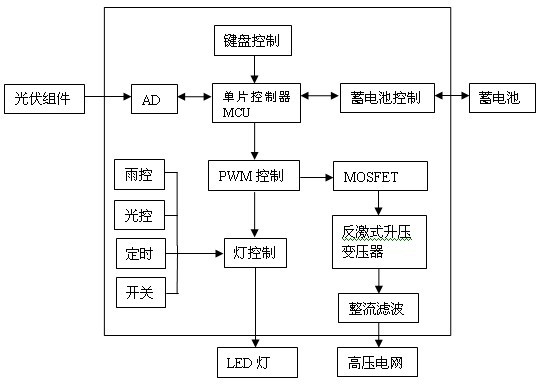Solar LED (light emitting diode) pest-killing lamp adopting flyback-boost and working method thereof
A technology of LED insecticidal lamps and LED lamps, which is applied to the application, devices for catching or killing insects, semiconductor devices of light-emitting elements, etc., can solve the problems of reducing the effect of attracting insects, unfavorable promotion, and automatically turning off lights, etc., to achieve improved Stability and reliability, prolonging the life of LED lamps, and reducing the cost of use
- Summary
- Abstract
- Description
- Claims
- Application Information
AI Technical Summary
Problems solved by technology
Method used
Image
Examples
Embodiment Construction
[0028] The present invention will be further described below in conjunction with specific examples.
[0029] Such as figure 1 , a kind of solar LED insecticidal lamp adopting flyback step-up of the present invention, it comprises:
[0030] Including photovoltaic modules, batteries, LED lights and high-voltage power grids. In addition, the insecticidal lamp also includes AD conversion modules, intelligent control boards, single-chip controllers MCU, battery control modules, PWM controllers, MOSFETs ), a flyback step-up transformer and a rectifier filter module. The photovoltaic module is connected to the battery through the AD conversion module, the single-chip controller MCU, and the battery control module. The single-chip controller MCU is also connected to the PWM controller. It is connected to the high-voltage power grid through MOSFET, flyback step-up transformer, and rectification and filtering module, and the other is connected to LED lights.
[0031] The keyboard cont...
PUM
 Login to View More
Login to View More Abstract
Description
Claims
Application Information
 Login to View More
Login to View More - R&D
- Intellectual Property
- Life Sciences
- Materials
- Tech Scout
- Unparalleled Data Quality
- Higher Quality Content
- 60% Fewer Hallucinations
Browse by: Latest US Patents, China's latest patents, Technical Efficacy Thesaurus, Application Domain, Technology Topic, Popular Technical Reports.
© 2025 PatSnap. All rights reserved.Legal|Privacy policy|Modern Slavery Act Transparency Statement|Sitemap|About US| Contact US: help@patsnap.com


